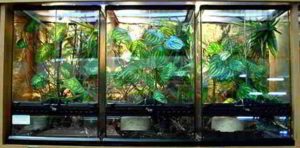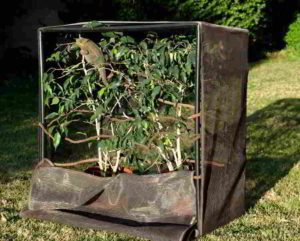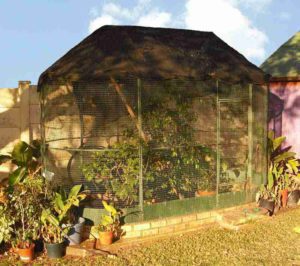Choosing the best cage for your chameleon
There is a great opportunity to house a chameleon in a cage that will be a focal point and an object of beauty in your house. Be warned: getting the best chameleon cage involves planning and expense!
Whatever cage you decide on must be escape-proof. Chameleons are master escapologists. Your plump Veiled will have no difficulty in compressing laterally and slipping through a narrow gap.
Once the chameleon has disappeared you may not see him again. A chameleon can run at a surprising speed and if it reaches the garden the chances of recovery are slim. Just as easily, crickets can squeeze through small holes. So, an insect-proof cage is also desirable to avoid a house overrun with chirping insects.
Size is important
The size of your chameleon’s cage depends on your budget, the type of chameleon, the space available in your home, and other factors described below. Remember to take into account the age of your chameleon.
Juveniles will not do well in big cages. Depending on the layout, it’s surprisingly easy for a small chameleon to starve in a large cage. By nature, smaller chameleons are more cautious and will tend to hide. They often stay higher in the cage, so placing food low in the cage or out in the open, could mean it’s ignored. Pygmy chameleons and neonates will be discussed in a later post. For now, let’s focus on the adults of true chameleons.
Adult True Chameleons
The variation and possibilities for housing an adult chameleon are nearly endless. To avoid costly mistakes, consider the following before designing a little piece of the rainforest in your living room. (Not least of which is – does you chameleon really come from rain forest?)
The following basic requirements must be met.
The housing must be:
- well ventilated
- escape proof
- allow for ultraviolet light
- allow for temperature management
- have suitable drainage.
Once these are in place, your imagination can run riot.
Unless the chameleon cage you use is very large, it should only contain one adult chameleon. It may look like your pair of Veiled chameleons are getting along well but it is an unnatural situation and one or both of them will become stressed.
Glass Cages
Glass can create many problems in a chameleon cage:
- Ventilation issues
- Lime scale
- Reflections
- Damage to the tongue
- Poor drainage
Let’s consider these one at a time.
Ventilation
One of the biggest killers (aside from the lack of UV) in the early days was poor ventilation. At that time, everyone assumed high humidity reflected the natural conditions in the wild. This is only true for a limited number of species. Veiled, Panthers, Carpet chameleons, and many others need good ventilation. Poor ventilation leads to respiratory problems.
Glass cages are difficult to ventilate properly. Some very large cages, often custom-built, use glass and have excellent ventilation, but many do not.
Limescale
If you’re spraying your chameleon sufficiently, you are likely to end up with limescale on the glass. That’s the nasty white crust that builds up quickly from hard water but can result from anything except distilled. It’s unattractive and hard to remove.
Reflection

Glass will reflect an image of the chameleon back into the cage. This may cause it to use a variety of display stances and colours to make the ‘intruder’ leave its territory. Obviously, the reflected ‘intruder’ will match each display exactly. Stress will result.
It is possible to place the cage and lights in ways to minimise the reflection but if it’s not done well, you will have problems. A few species are not anti-social but Veiled and Panther chameleons will not be happy.
Tongue Damage
If the glass is kept very clean, the chameleon will not see it. A fly landing on the outside of the cage will get ‘shot’ but the unforgiving nature of the glass may, in rare cases, damage the tongue.
Poor drainage
Many glass cages have glass bases and are sealed around the base. If the chameleon cage is sprayed with enough water several times a day, the bottom of the cage will be deep in water! Making holes in the base is possible but not without the risk of cracking the base.
Does that mean I can’t use glass?
Where possible, I would say ‘no to glass’. However, I have kept chameleons in the UK and used glass-fronted cages. I have friends with various species that also use glass due to the climate there.
In such cases, these are glass cages designed for reptiles. An old fish tank is not the same thing and will lead to all sorts of problems.
In climates where heating is essential, for many enthusiasts, it’s not practical to heat a room and use net cages. A glass cage is the only option. With care and planning, a glass cage can provide effective housing. It would never be my first choice, but it would be silly to ignore them.
Netting Cages

The cages I have used very successfully over many years are netting cages covering a light plastic tubular frame. The ones I use are Exo Terra flexariums but other brands sell equally good versions.
The benefits of these netting cages are:
- good ventilation,
- they allow ultraviolet light
- good drainage for heavy spraying
- light enough to carry outdoors when the weather permits
- easily cleaned
- available in a variety of sizes (although not so much with Exo Terra these days).
The negative factors of these cages are
- they can be expensive
- they are not attractive indoors
- the netting is not strong enough to stop crickets chewing
- the zips can prove troublesome after a while.
Furthermore, it is important to remember the netting stops about 40% of the UV light passing through. Despite these drawbacks, I have found them to be the ideal cage for the chameleons that are available in South Africa and Malaysia.
Other types of chameleon cage
Bird cages
In desperation, I once used a large parrot cage as a makeshift home for an unexpected Meller’s chameleon. I did not like the thin bars. This is due to the danger that the chameleon will start to climb the thin wires but be unable to maintain its footing and fall. I also found that the chameleon rubbed its nose on the wire.
Other people, however, have used a similar style of cage for large Veiled chameleons with some success. I would avoid using these as a cage for your chameleon if possible.
Aviaries

During the summer, an aviary can be used to good effect. I have bred Veiled chameleons in an aviary, keeping one male and several females together without any signs of aggression or stress. The aviary I used was 4 metres long by 2 metres wide. I put lots of different plants in the cage. This gave a lot of space for each chameleon to hide from others or to go through the mating cycle in almost natural conditions.
I have bred Veiled chameleons in an aviary, keeping one male and several females together without any signs of aggression or stress. The aviary I used was 4 metres long by 2 metres wide and heavily planted in the centre. This gave each chameleon a lot of space to hide from others or to go through the mating cycle in almost natural conditions.
When using an aviary there are certain factors that should be considered. In South Africa, birds can pose a problem. I lost a large male Jackson’s chameleon that was attacked through the wire by weaver birds. When I opened the aviary door to rescue the chameleon, the birds actually flew inside the aviary to continue their assault! I suspect this was unusual as it has not happened with any chameleons since, and I have kept several species quite happily in the same aviary.
I placed shade netting across the top of the aviary to protect it from heavy hail or rain.
Conclusion
Whatever style of chameleon cage you choose, ensure that it has proper drainage to prevent water logging and excessively high humidity. It should also be easy to clean.
There is little point in having an elaborate, well-planted cage, mimicking the rain forests of Uganda if you cannot clean it easily, and it poses a health risk to your chameleon. But that raises the same question as at the beginning – does your chameleon come from the rain forests of Uganda. Probably not.
Therefore, it’s important to research the conditions found in the chameleon’s natural location and learn how other people have set up their cages.
Finally, don’t forget other considerations such as UV light, the strength of which falls off alarmingly, and the provision of water. I will cover these in later posts.
Any comments, thoughts or suggestions are welcome.
